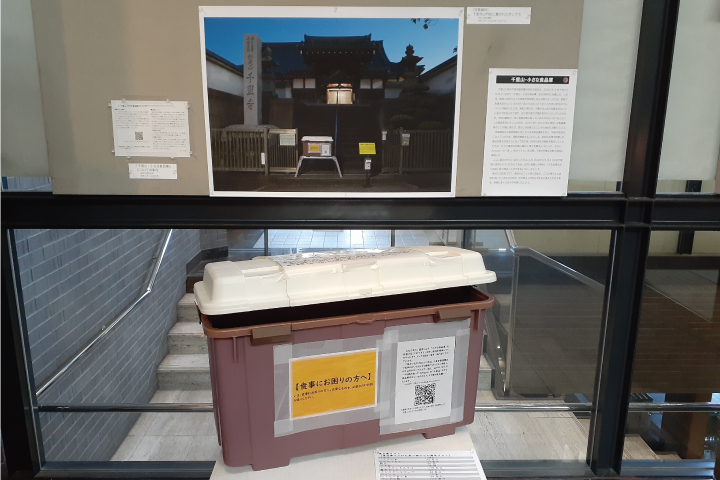
March 30, 2021
Preserving the Tangible and Intangible for the Next Century – The Efforts of Suita City Museum During the COVID-19 Pandemic
Kenji Saotome
Suita City Museum, Osaka, Japan
1 .Introduction
Suita City Museum in Osaka Prefecture has been collecting local objects related to COVID-19 since February 2020. In trying to find clues as to how to tackle the current pandemic, the museum searched for local historical documentation and objects related to the outbreak of the Spanish Flu that occurred a century ago, only to find there were none – Thus began this initiative to “collect objects related to COVID-19 for the next century.” While government documents are relatively easy to collect and preserve, we instead focused on collecting objects related to everyday economic, social, and cultural activities that are quite often disposed of after serving their purpose. Along with those objects, we documented stories and experiences by local people whose lives have been affected by COVID-19. We believe that everything we have collected will serve a different purpose from that of government documents or statistical data if the future generation is ever faced with another similar pandemic.
2 .List of Collected Objects
As of January 15, 2021, the museum acquired a total of 2,843 objects. The breakdown is as follows.
- Various leaflets
- Newsletters (commercial organizations, etc.)
- Newsletters (public facilities and non-profit organizations)
- Newspapers
- Postcards and letters
- Restaurants and other food service-related objects
- Catalogs (commercial organizations)
- Medical and health-related objects
- School-related objects
- Government documents
- City newsletters
- Work union-related documents
- Notices (commercial organizations)
- Notices (public facilities and non-profit organizations)
- Posters, etc. (museums)
- Three-dimensional objects (face shields)
- Three-dimensional objects (masks)
- Three-dimensional objects (other)
- Other
The acquisition further includes 1,124 items, such as photographic and written data. However, the museum is facing unforeseen difficulties in collecting, preserving, and utilizing digital data with the current Suita City Museum Ordinance, object donation application forms, and object deposit application forms. The digital data has been provisionally collected, but the museum is unable to “officially” accept them into a system for preservation. We are currently under discussion with the museum director to create a system that is up to date. Below are some of the objects, stories, and experiences we have collected.
3-1.Small Food Bank of Senriyama
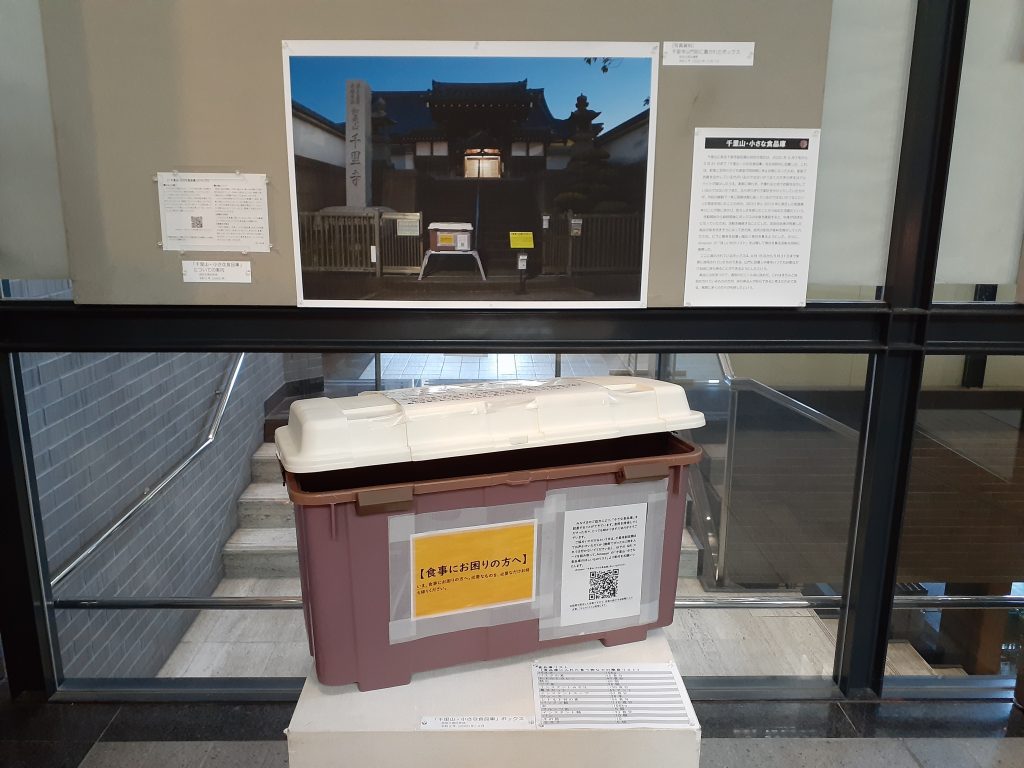
Mr. Daishin Takeda, Deputy Chief Priest of Senri Temple in Senriyama, Suita City, Osaka, set up the “Small Food Bank of Senriyama” in his temple from late March to May 31, 2020. “After school lunches and local children’s cafeteria had closed at around the same time, I began to wonder if there might be children going hungry in their own homes who depended on these institutions. I also thought the local university students whose part-time work hours have been reduced. I worried that they were fighting hunger in isolation, unable to travel back to their hometowns to be with their families at their time of need. Then I began to think about the families who were barely making ends meet even before the pandemic and have slipped into poverty.” Mr. Takeda spoke of his concern that became the foundation for this project.
A few hours after the start of this project, Mr. Takeda found the contents of the box almost empty and became determined to continue this endeavor. But this project could not have continued without the help of his generous neighbors who donated food when he was running low on his own stock. Mr. Takeda also began widely soliciting donations by setting up flyers and signs, as well as a donation wish list on Amazon.
The box in Figure 1 (in the front of the photograph) is the actual box that was used from April 15 to May 31, 2020. He explains that the box was intentionally placed near the main temple gate so that people could take as much food as they needed, whenever they wanted, without having to interact with temple workers.
3-2.Documents Provided by Cancer Patient and Patient’s Family
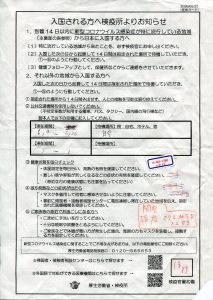
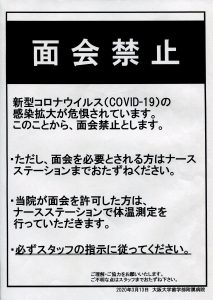
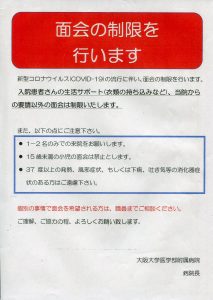
The quarantine-related document was donated from a family member who had temporarily returned to Japan from South Korea to meet with a patient who was critically ill. Per the “Notice from the Quarantine Station to Persons Entering Japan,” the family member was requested to self-isolate for two weeks from June 9 to 23, 2020. The other documents were also donated from the family member when the patient was transferred from Osaka University’s School of Dentistry to its Faculty of Medicine. On these forms are the guidelines prohibiting or limiting visitors due to the pandemic. Unfortunately, the patient passed away from cancer on June 18, while the family member was still self-isolating. On the reverse side of “Notice from the Quarantine Station to Persons Entering Japan” (Figure. 2-1), South Korea is listed as one of the “Areas with Particularly High Risk.”
The acquisition of these documents was made possible by citizens who are deeply associated with the museum and were able to ask for donations on an expansive scale within their communities. These documents were donated just two weeks after the patient passed away.
3-3.Objects Related to “Coronavirus Vigilantes (Jishuku Keisatu)”
The following two objects are not directly related to Suita City, Osaka but we find them extremely interesting as they were created by people with opposing perspectives and opinions regarding the travel restrictions and restraint of social/economic activities during the COVID-19 pandemic. Not many museums in Japan are collecting objects related to COVID-19, so we think it is our duty to find meaning in these objects and preserve them in our collection for future generations.

The object in Figure 3 was donated by a friend of a citizen of Suita City, Osaka; on it is written, “My [license plate] number is from another prefecture, but I live in Shizuoka.” In the midst of requests for voluntary travel restrictions between prefectures, this sticker was created by an individual who commutes to work by car between Kanagawa and Shizuoka Prefecture. The backside is a magnet so it can be attached to the side of a car. The individual placed this magnet on their car before crossing from Kanagawa to Shizuoka Prefecture for self-protection from these so-called “coronavirus vigilantes.” At the time, these self-righteous vigilantes monitored businesses and cars that traveled from prefectures with a high infection rate, and took it into their own hands to prevent the spread of the virus.
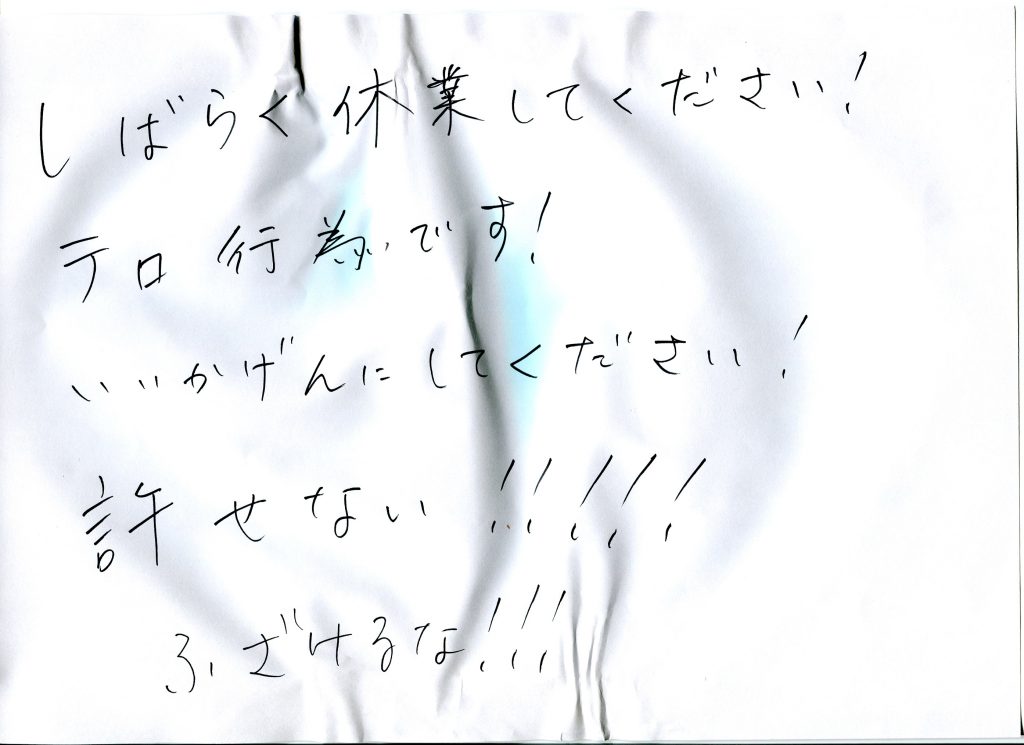
The note in Figure 4 was donated by a bar owner in Toyonaka City which neighbors Suita City, Osaka. At around 10 a.m. on April 15, 2020, a friend of the owner found a note posted at the entrance of the bar by the “coronavirus vigilantes.” After being contacted by their friend, the owner verified and collected the note at around 1 p.m. On the A4-sized paper it said, “CLOSE YOUR SHOP! THIS IS AN ACT OF TERROR! JUST STOP!!!! IT’S UNFORGIVABLE!!! SCREW YOU!!!” The owner donated the note to the museum about five months after it was found. The owner had kept the note due to the possibility of submitting it for a police investigation. After five months, the owner judged it was no longer necessary and donated it. The donation was made possible because the museum employees frequented the bar and knew the owner.
4.Conclusion
COVID-19 has brought among us an unprecedented uncertainty that is seeping through the social fabric and to all of its citizens. It is an opportunity for us all to reevaluate our own actions and motivations from an objective standpoint and realize that the definition of “right” and “wrong” depends solely in the eye of the beholder. There is no guarantee that the common sense and ideals we have upheld will match those of the future. Especially in times of great uncertainty, we are required to raise the standard in which we think and ultimately make decisions. If ever we are faced with another precarious situation, our hope is that these artifacts that we have collected pertaining to COVID-19 will become a benchmark for those in need. We started this collection as a means to preserve tangible objects that were in danger of being disposed of, but as we dug deeper, we realized that records of experiences and stories of the pain and distress that the people experienced firsthand may have a stronger impact and provide a greater insight for the future that is still uncertain.
Moreover, we believe that this collection of objects and documented experiences and stories will serve as an exemplar for generations to come but is inspiring many even today. From July to August 2020, the museum organized an exhibition on COVID-19 with objects collected during the pandemic. The exhibition received excellent ratings through the visitor survey and has received wide media coverage by newspapers and television as well as interest from domestic and international academic associations. We are currently working on a second COVID-19 exhibition set for summer of 2021. The COVID-19 pandemic started in the recent past, but it is also ever-present and evolving. We are working on creating an exhibition space that will allow viewers to examine the pandemic as such from an objective viewpoint. We will continue our efforts and strive to be a museum that contributes to identifying and solving issues of modern society.
(Kenji Saotome)